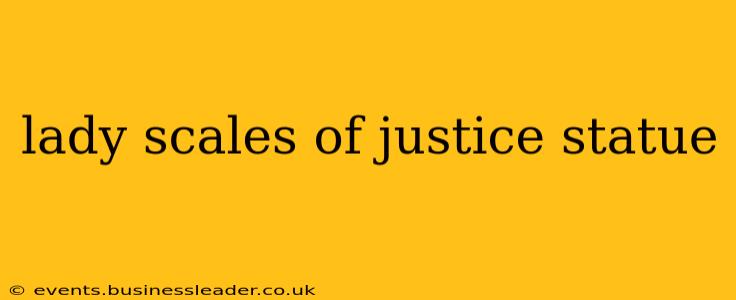The Lady Justice statue, a ubiquitous symbol of the legal system worldwide, is more than just an ornamental piece. Its powerful imagery, particularly the scales of justice she holds, speaks volumes about the principles of law and fairness. This article delves into the history, symbolism, and significance of this iconic figure, answering some common questions surrounding her representation.
What Does the Lady Justice Statue Symbolize?
The Lady Justice statue embodies the ideals of justice, fairness, and impartiality within the legal system. She represents the pursuit of truth and the equitable application of the law, regardless of social standing, wealth, or influence. Each element of her traditional depiction—the scales, blindfold, and sword—contributes to this powerful symbolism.
What Do the Scales Represent in the Lady Justice Statue?
The scales held in Lady Justice's hands represent the weighing of evidence and arguments in a legal case. They symbolize the impartial consideration of all sides of a dispute before a judgment is rendered. The balance of the scales signifies the need for equitable treatment and the importance of objective assessment in reaching a fair outcome. An imbalance suggests a bias or unfair verdict.
What Does the Blindfold on Lady Justice Symbolize?
The blindfold worn by Lady Justice is perhaps the most recognizable aspect of her portrayal. It symbolizes impartiality and objectivity. The blindfold signifies that justice should be blind to personal biases, prejudices, influence, or external pressures. Justice should be meted out based solely on the facts presented and the law applied, not on who the parties are or their social connections.
What Does the Sword in Lady Justice's Hand Symbolize?
While not always present in every depiction, the sword held by Lady Justice symbolizes the power of the law and its ability to enforce justice. It represents the authority to punish wrongdoers and uphold the law, ensuring that justice is not only sought but also achieved. It complements the scales, indicating that justice isn't merely a theoretical concept but a force that can be actively enacted.
Why is Lady Justice Depicted as a Woman?
The depiction of Justice as a female figure has ancient roots, drawing parallels to goddesses of justice and wisdom in various mythologies. While the reasons aren't definitively singular, it’s often suggested that the choice reflects the ideal of justice as nurturing, protective, and insightful. Over time, the feminine portrayal has come to represent a more compassionate and understanding aspect of the legal process.
What are the Different Variations of the Lady Justice Statue?
While the core elements remain consistent, variations exist in the portrayal of Lady Justice across different cultures and eras. Some statues may depict her with different attire, poses, or accessories. The specific details can be influenced by regional artistic styles and legal traditions. However, the fundamental symbolism of impartiality, fairness, and the pursuit of truth consistently remains.
Where Can I Find Lady Justice Statues?
Lady Justice statues are found prominently in courthouses, law schools, and government buildings worldwide. They serve as a constant reminder of the ideals that underpin the legal system and the pursuit of justice. Their presence emphasizes the importance of fairness and impartiality within the legal process.
This exploration of the Lady Justice statue highlights the rich symbolism embedded within this iconic figure. Each element of her representation – the scales, blindfold, and sword – contributes to the powerful message of impartiality, fairness, and the unwavering pursuit of justice. Understanding this symbolism fosters a deeper appreciation for the principles that underpin our legal systems and the ongoing quest for equitable treatment for all.
